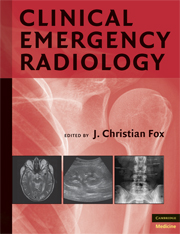Book contents
- Frontmatter
- Contents
- Contributors
- PART I PLAIN RADIOGRAPHY
- PART II ULTRASOUND
- PART III COMPUTED TOMOGRAPHY
- 28 CT in the ED: Special Considerations
- 29 CT of the Spine
- 30 CT Imaging of the Head
- 31 CT Imaging of the Face
- 32 CT of the Chest
- 33 CT of the Abdomen and Pelvis
- 34 CT Angiography of the Chest
- 35 CT Angiography of the Abdominal Vasculature
- 36 CT Angiography of the Head and Neck
- 37 CT Angiography of the Extremities
- PART IV MAGNETIC RESONANCE IMAGING
- Index
- Plate Section
33 - CT of the Abdomen and Pelvis
from PART III - COMPUTED TOMOGRAPHY
Published online by Cambridge University Press: 07 December 2009
- Frontmatter
- Contents
- Contributors
- PART I PLAIN RADIOGRAPHY
- PART II ULTRASOUND
- PART III COMPUTED TOMOGRAPHY
- 28 CT in the ED: Special Considerations
- 29 CT of the Spine
- 30 CT Imaging of the Head
- 31 CT Imaging of the Face
- 32 CT of the Chest
- 33 CT of the Abdomen and Pelvis
- 34 CT Angiography of the Chest
- 35 CT Angiography of the Abdominal Vasculature
- 36 CT Angiography of the Head and Neck
- 37 CT Angiography of the Extremities
- PART IV MAGNETIC RESONANCE IMAGING
- Index
- Plate Section
Summary
INDICATIONS
Since its inception, CT has greatly aided in the diagnosis of intraabdominal and pelvic pathology. The rapid diagnosis of underlying pathology in the “acute abdomen” is critical to help reduce the rates of morbidity and mortality from delayed diagnosis. Physical examination and laboratory findings are often non-specific, so efficient diagnostic tools are essential. CT scanning has widely become the diagnostic test of choice for patients presenting with abdominal or pelvic pain and for the stable trauma patient to evaluate for intraabdominal injury. Various studies show sensitivities of 69% to 95% and specificities of 95% to 100% for the diagnosis of bowel and mesenteric injuries with CT (1). The sensitivities for diagnosing solid organ injuries are even higher.
Because of the limitations of plain radiographs, CT scanning is also being increasingly used in cases of bowel obstruction to help delineate the location, severity, and underlying cause of the obstruction. For high-grade obstructions, CT has a sensitivity of 96%; it is less accurate for low-grade obstructions (1). In addition, CT with water-soluble contrast may be both therapeutic and diagnostic because the contrast material may favor intraluminal absorption of water and diminution of bowel wall edema, allowing resolution of mechanical small bowel obstruction. The ability to generate reconstructions in different planes on multidetector CT (MDCT) has enabled the clinician to determine whether a closed-loop obstruction is present.
Keywords
- Type
- Chapter
- Information
- Clinical Emergency Radiology , pp. 473 - 481Publisher: Cambridge University PressPrint publication year: 2008

